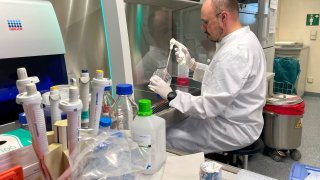
- Monkeypox is spread primarily through close physical contact and people are most infectious when they have rashes on their body, according to the Centers for Disease Control and Prevention.
- The virus can also spread through respiratory transmission when a person has lesions in their throat or mouth, but this requires prolonged contract.
- "This is not Covid," Dr. Jennifer McQuiston, a CDC official, said. "Respiratory spread is not the predominant worry. It is contact and intimate contact in the current outbreak setting and population."
The Centers for Disease Control and Prevention wants to calm public anxiety over how the monkeypox virus is transmitted, emphasizing that it doesn't spread that easily through the air because it requires close contact with an infected person.
Monkeypox is primarily spread through sustained physical contact such as skin-to-skin touch with someone who has an active rash, CDC officials said this week. The virus can also spread through contact with materials that have the virus on it like shared bedding and clothing. But it can spread through respiratory droplets as well, although not nearly as easily as Covid-19, they said.
A monkeypox patient with lesions in their throat or mouth can spread the virus through respiratory droplets if they are around someone else for an extended period of time. However, the virus does not spread easily that way, according to Dr. Jennifer McQuiston, a CDC official.
Get top local stories in Southern California delivered to you every morning. >Sign up for NBC LA's News Headlines newsletter.
"This is not Covid," McQuiston told reporters on a call Monday. "Respiratory spread is not the predominant worry. It is contact and intimate contact in the current outbreak setting and population."
For example, nine people with monkeypox took lengthy flights from Nigeria to other countries without infecting anyone else on the planes, according to McQuiston.
"It's not a situation where if you're passing someone in the grocery store, they're going to be at risk for monkeypox," she said.
Money Report
The lesions that characterize monkeypox are the source from which the virus spreads, and people are most infectious when these lesions appear on the skin, according to Dr. John Brooks, a medical epidemiologist at the CDC's division for AIDS prevention.
However, Brooks said front-line health-care providers should use the standard precautions for infectious diseases when treating a patient with monkeypox, including wearing a N95 respirator mask, gloves and a gown if contact with the patient is particularly close.
The U.S. has confirmed one monkeypox case in Massachusetts and four presumed cases in New York City, Florida and Utah that need further analysis. The CDC sequenced the virus from the Massachusetts patient within 48 hours and found a patient match in Portugal, McQuiston said. It's likely that additional cases will be reported in the coming days, she said.
The recent monkeypox cases in the U.S. and around the world have been identified as the West African strain, a milder form of the virus. Monkeypox is in the same family as smallpox, but is not as severe. Most people who are infected with this strain of monkeypox recover in two to four weeks without specific treatment, McQuiston said.
Monkeypox usually begins with symptoms similar to the flu including fever, headache, muscle aches, chills, exhaustion and swollen lymph nodes. The disease then progresses to rashes that can spread to different parts of the body including the face, eyes, hands, feet, mouth or genitals. These rashes turn into raised bumps that become blisters. However, the rashes have appeared first in some of the recent cases.
The World Health Organization has identified about 200 confirmed or suspected cases in at least a dozen countries. The recent outbreaks are unusual because they are occurring in North American and European countries where the virus is not endemic, like in Africa. Monkeypox is usually found in West and Central African rainforests, home to animals that carry the virus live.
The WHO said this week the current virus appears to spreading among men who have sex with men. Brooks, the CDC official, alerted gay and bisexual men to the potential risk, though he emphasized that anyone can catch the virus regardless of sexual orientation.
Brooks said monkeypox is not a sexually transmitted disease, which generally spreads through semen and vaginal fluids. It's important for physicians and individuals to know that some of the current patients have anal or genital lesions that can be confused with sexually transmitted diseases such as herpes or syphilis in addition to chickenpox, Brooks added.
"Anyone with a rash or lesion around or involving their genitals, their anus or any other place that they have not seen it before, should be fully evaluated, both for that rash but particularly for sexually transmitted infection and other illnesses that can cause rash," he said.
The CDC plans to increase its public health messaging ahead of LGBTQ Pride Month, which starts in June, so people in the community are aware of the situation, Brooks said.
The recent monkeypox outbreak in multiple countries is also different from Covid because there are already federally approved vaccines effective in preventing monkeypox. The U.S. has a stockpile of 100 million doses of an older generation smallpox vaccine called ACAM2000, which can be used to protect against monkeypox, though it can have significant side effects and any decision to distribute it widely would require serious discussion, McQuiston said.
There's another vaccine, Jynneos, that targets smallpox and monkeypox and does not have the same risk of significant side effects. It is administered in two doses for people ages 18 and older who are high risk of smallpox or monkeypox. However, the U.S. only has 1,000 available doses of this vaccine, though the drugmaker Bavarian Nordic will start ramping up its production in the coming weeks, McQuiston said.






